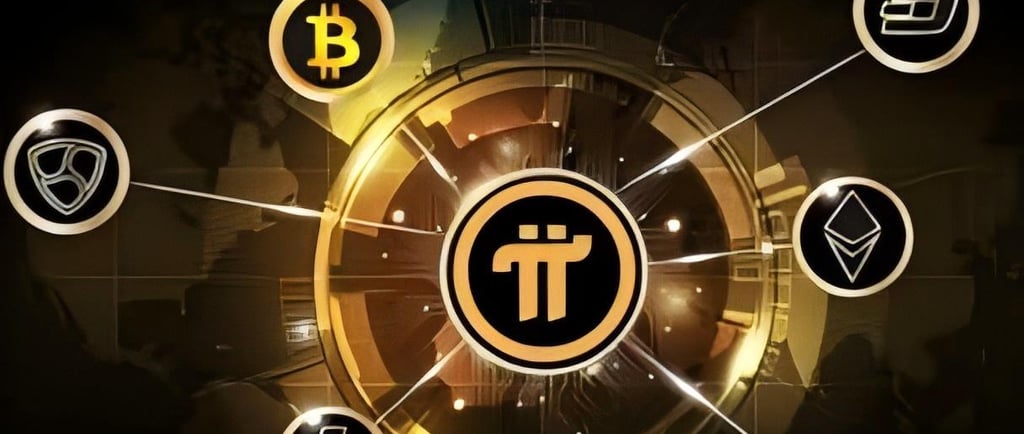Exploring Pi Network – The Mobile Crypto Revolution
It seems likely that its community-driven approach, with over 40 million users, drives both its appeal and controversy. The evidence leans toward Pi’s future hinging on adoption and ecosystem growth, with trading now live on exchanges like OKX.
3/2/20253 min baca


Welcome to the World of Pi
Hey there, crypto enthusiasts! Today, we’re diving into Pi Network, a project that’s been turning heads since its launch on March 14, 2019, by a team of Stanford grads. Unlike Bitcoin’s energy-hungry mining rigs, Pi lets you mine cryptocurrency right from your smartphone—no fancy hardware required. With its mainnet finally live as of February 20, 2025, and Pi coins now tradeable, it’s time to unpack what makes Pi tick, why it’s got over 40 million users, and whether it’s worth your attention. Let’s get started!
What’s Pi Network All About?
Picture this: a cryptocurrency you can mine with a daily tap on your phone. That’s Pi Network in a nutshell. Built on the Stellar Consensus Protocol (SCP), it uses a trust-based system where users form “security circles” to validate transactions—think of it like a digital handshake. No battery drain, no hefty electricity bills—just a simple app check-in. The kicker? You need an invitation code (try Vivi7567!) to join, linking you to a global community that’s ballooned to over 70 million claimed users by January 2025.
The Mainnet Milestone
Big news dropped on February 20, 2025: Pi’s mainnet launched, and Pi coins hit exchanges like OKX, Bitget, and gate.io. Trading kicked off with a bang—$3.47 billion in 24-hour volume—and the price has been a wild ride, peaking at $1.97, dipping over 60%, and bouncing back to $0.76-$2.26 as of March 2, 2025. For the 19 million KYC-verified Pioneers who migrated, it’s a chance to cash out or hodl. This shift from “mining-only” to “tradeable” has put Pi under the spotlight—can it deliver on its promises?
Why the Buzz?
Pi’s appeal is simple: accessibility. Anyone with a smartphone can join, making it a crypto for the masses. The social twist—earning boosts via referrals and security circles—adds a fun, community vibe. Pre-mainnet, mining started at 3.1415926 Pi per hour (a nod to π!), halving as the network grew. Now, with lockups stretching to 2027-2029, it’s about building an ecosystem. Over 80 dApps are ready, hinting at real-world use, from marketplaces to DeFi tools. It’s eco-friendly too, dodging Bitcoin’s carbon footprint.
The Controversy Corner
Not everyone’s sold on Pi. Critics call it a scam, pointing to delays and a pyramid-like referral system. X posts from folks like Bybit’s CEO fuel the fire, warning it might prey on hopefuls. Reddit threads debate its value—currently volatile at $0.76-$2.26 with IOU’s at $1.67—since it’s not on Binance yet. But defenders argue its Stanford roots, app store vetting, and sheer scale (40M+ users) prove legitimacy. It’s a classic crypto divide: hype vs. substance.
What’s Next for Pi?
The road ahead looks exciting—and bumpy. Predictions for 2025 range from $10 flops to $200 highs, depending on adoption and listings. By 2030, some see $500+ if Pi becomes a go-to for payments or Web3. With a max supply of 100 billion coins (80% for the community), inflation’s a risk, but lockups could stabilize it. The real test? Growing beyond miners to everyday users. If Pi nails its dApp ecosystem and snags major exchange nods, it could soar. If not, it risks fading into obscurity.
Join the Pi Party
Curious? Grab your phone, download the Pi Network app, and use Vivi7567 to jump in. Mine a little Pi, join the community, and see where this ride takes you. Whether you’re a skeptic or a believer, Pi’s a fascinating experiment—part social network, part crypto dream. Will it redefine money or just be a fun footnote? Only time will tell. What do you think—drop your thoughts below!
